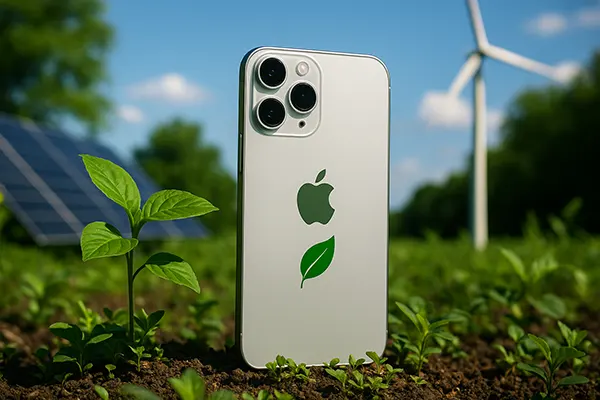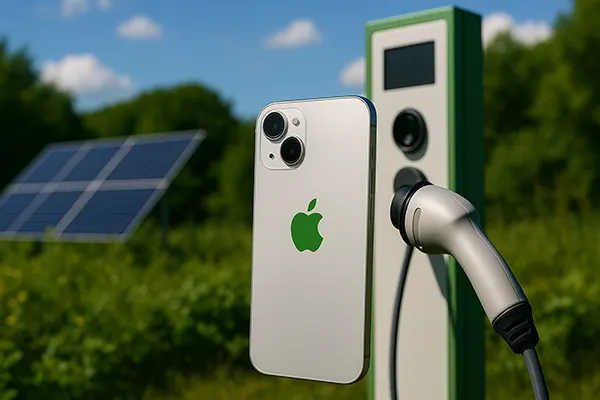
Apple’s Environmental Initiatives in 2025: How Eco-Strategies Shape Products and Users
In 2025, Apple stands as one of the leading technology innovators driving global change toward sustainability. Through its environmental strategy, the company continues to reduce carbon emissions, improve recyclability, and create a transparent supply chain. Apple’s eco-initiatives not only shape the design and production of its devices but also influence user behaviour, promoting responsible technology consumption.
Apple’s Carbon Neutral Commitment and Global Impact
Apple achieved full carbon neutrality across its corporate operations in 2020 and remains committed to extending this achievement to its entire product line by 2030. As of 2025, more than 80% of Apple’s suppliers have transitioned to renewable energy sources, significantly reducing global CO₂ emissions throughout the company’s supply chain. This initiative has made Apple one of the largest corporate buyers of clean energy worldwide.
Manufacturing remains Apple’s biggest environmental challenge, and the company has introduced cleaner production methods, including the use of recycled aluminium and rare earth elements in MacBooks, iPhones, and iPads. This strategy has cut the average carbon footprint of a new iPhone by nearly 20% compared to 2020 models.
Apple’s renewable energy projects now power operations in over 43 countries, including large solar and wind farms across the United States, China, and Europe. These investments are not only about reducing emissions but also about creating a resilient energy infrastructure for future generations.
How Apple Encourages Supplier Responsibility
Apple’s Supplier Clean Energy Programme, introduced in 2015, has evolved into a global standard for environmental accountability in 2025. The company provides partners with guidance and funding to transition to renewable energy and adopt sustainable materials. Over 300 suppliers now operate using 100% renewable energy for Apple production lines.
In addition to energy goals, Apple demands compliance with strict water management and waste reduction standards. Many suppliers have adopted circular production systems, which reuse materials and limit landfill waste. This approach aligns Apple’s sustainability vision with real-world industrial responsibility.
Transparency has also become a core part of Apple’s supplier engagement. The company now publishes annual progress reports detailing environmental compliance, emissions data, and third-party audit results. This openness fosters accountability across the global supply network.
Recycling, Repairability, and Material Innovation
Apple continues to expand its recycling and reuse programmes through advanced robotics and improved product design. The Daisy and Dave robots, operating in 2025, disassemble millions of iPhones annually to recover valuable components like cobalt, tungsten, and rare earths. These materials are then reintegrated into the production cycle, lowering dependency on mining.
The company’s latest devices are engineered for greater repairability. Apple has expanded its Self Service Repair programme to more regions, empowering consumers to replace batteries, displays, and key components safely. This initiative not only prolongs device life but also fosters environmental awareness among users.
In terms of materials, Apple has introduced a fully recycled aluminium enclosure across the MacBook Air and iPad lineup, and a bio-based polymer frame in selected Apple Watch models. These innovations reflect the company’s ongoing investment in material science as part of its eco-design philosophy.
The Role of Product Longevity
Apple’s sustainability strategy is closely linked to the longevity of its products. The company provides software updates for older devices for up to seven years, extending their usability and reducing electronic waste. This long-term support model encourages customers to keep devices longer, minimising the need for frequent replacements.
Additionally, Apple’s trade-in programme has expanded to include a broader range of devices, from iPhones to MacBooks. Users receive credit towards new purchases, while returned products are refurbished or recycled responsibly. This circular economy model benefits both the environment and consumers.
By prioritising durability and efficient performance, Apple reinforces a culture of mindful consumption. The approach redefines what it means to innovate responsibly in a rapidly evolving technology landscape.

Apple’s Broader Influence on Users and the Industry
Apple’s environmental commitments extend beyond its products. In 2025, the company continues to influence millions of users through initiatives such as the Earth Day Challenges on Apple Watch, educational campaigns, and eco-features within iOS and macOS that track energy use and carbon footprint.
These programmes are designed to make sustainability part of everyday digital habits. Features like optimised charging, low-power modes, and eco-friendly default settings help users lower their personal energy consumption without compromising performance.
Apple also collaborates with environmental organisations worldwide, including Conservation International and the World Wildlife Fund (WWF), to restore forests, wetlands, and mangroves. These projects offset carbon emissions while promoting biodiversity and natural climate solutions.
How Apple Shapes the Future of Green Technology
Apple’s influence pushes the entire tech industry towards higher sustainability standards. Competitors now emulate Apple’s environmental transparency and renewable energy goals, leading to broader industry transformation. The company’s innovation serves as both a benchmark and a motivator for global change.
Through consistent investment in green research and development, Apple continues to pioneer advancements in recyclable materials, low-emission manufacturing, and closed-loop production systems. These efforts align environmental goals with economic growth, proving that sustainability can drive profitability.
As 2025 unfolds, Apple’s role in environmental leadership extends far beyond technology. It sets a precedent for corporate responsibility, inspiring both consumers and industries to participate in building a sustainable future.
Related articles
-
 MacBook 2025: Real Changes Brought by...
MacBook 2025: Real Changes Brought by...The 2025 MacBook generation marks a significant stage in Apple’s …
-
 Key Features of Renting a Server
Key Features of Renting a ServerThe World Wide Web is now increasingly being used to …
-
 Health and Wellness Accessories: The ...
Health and Wellness Accessories: The ...The Apple Watch remains one of the most advanced wearable …
